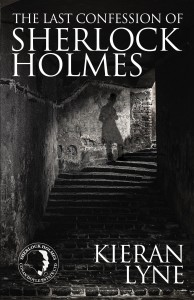Today I welcome a guest post by Kieran Lyne discussing Sherlock Holmes and the longevity of ‘The Hound of the Baskervilles’ as part of the Halloween 2014 series.
Some words possess a quality, a magic spark which instantly conjures certain images to our minds. If I were to say ‘Halloween’ for example, what would come to mind? Personally I instantly think of a headless horseman as I can recall a particularly unpleasant image of one on TV as a child, whereas that could well be the last thing on someone else’s mind.
There is something out there that scares the “bejesus” out of all of us: whether it’s Chandler Bing and his dancing Irishman, spiders, heights, responsibility, death, work, exercise, failure… Dale Winton. But what is it that makes some stories scarier than others? Not every book has us on edge, jumping at the slightest of sounds. And why is it that some stand the test of time, while others have been allowed to drift off into that bleakest of wildernesses, obscurity?
Though there are many titles which fill this criteria I have chosen one in particular from that miserable bunch we call the Victorians, ‘The Hound of the Baskervilles.’
Like Halloween the title is engrained in our culture and psyche. It has that magic and even if it doesn’t conjure up images to everyone it certainly evokes a sense of foreboding. ‘The Hound of the Baskervilles’ is the most iconic title relating to one of literature’s most iconic characters, Sherlock Holmes. Considering the popularity of criminal fiction it might seem a bit surprising that the great detective’s most famous case revolves around a spectral hound, but for many this is the Sherlock Holmes story, and I think I know why.
It is the masterful conflict between the pure logic of Holmes pitted against the horror of the hound.
To most, this will sound obvious. But what Conan Doyle expertly does is draws us deep within the horror of the story by convincing us that it might actually be true. We are introduced to the problem via a trustworthy source whose evidence we are not likely to dismiss as fanciful. By having Holmes and Watson dissect the character and therefore reliability of Dr. Mortimer before his arrival, we are already prepared to accept the validity of his testimony, which makes his revelation so chilling and memorable:
‘Mr. Holmes they were the footprints of a gigantic hound!’
This sets us on course, but after laying out this sinister and intriguing plot, Conan Doyle then separates Holmes from Watson and with it our sense of security, which is only heightened by a rare display of affection by Holmes toward his companion:
‘I give you my word that I shall be very glad to have you back safe in Baker Street once more.’
Watson is sent into the heart of this darkest of mysteries alone, which allows for a much greater sense of trepidation to build. The foreboding image of Baskerville Hall, a woman sobbing quietly in the night-time, and then the first sound of the dreaded hound sweeping across the moor, all combine to create a truly gripping atmosphere.
The hound is slowly building from myth into reality. There is undeniable proof of its existence: it leaves prints, howls across the moor, and even murders a man in cold blood; but it is through Holmes that our own fear is heightened:
‘ “Where is it?” Holmes whispered; and I knew from the thrill of his voice that he, the man of iron, was shaken to the soul.’
And this is what elevates ‘The Hound of the Baskervilles,’ and why it could only ever work to such a degree as a Sherlock Holmes story.
As most will know Holmes is not a usual detective: though he is the foremost champion of the law, he does not necessarily base his actions accordingly; he is the final court of appeal, and champions a higher power, logic. He is constantly searching for that tangible thread which will bring instant, rational clarity to what are often exceedingly complex or mysterious situations.
‘When you have eliminated the impossible, then whatever remains, no matter how improbable, must be the truth.’
The story is no longer simply about criminal vs detective: it is about the plausibility of myth, superstition, and horror triumphing over the purest form of rational thinking. It is tradition against modernity, belief over reason. It is unsurprising that this famous line was saved for the ‘Hounds of Baskerville’ episode in the BBC’s Sherlock, as in this instance the writers have flipped its reasoning: no longer is it an argument for rationale, but to question just what is possible and highlight how deeply shaken Sherlock has become. In no other genre could Holmes suffer this raw sense of conflict.
Fans of pure horror who like to escape into the realm of monsters and evil will perhaps not enjoy it because of this. But for those of us who find fright within the depths of plausibility and reality, ‘The Hound of the Baskervilles’ is still one of the best.
Kieran Lyne is a Suffolk-based author and writer of tongue-in-cheek reviews on Film, Literature and F1. His debut novel, The Last Confession of Sherlock Holmes, was released in September 2014 and he is the youngest writer to be endorsed by the Arthur Conan Doyle Estate. He is currently penning a set of Holmes short stories which he hopes to release in 2015, and also plans on writing another Holmes novel, as well as his own original material.
You can find out more about Kieran at his website or on Twitter.
About The Last Confession of Sherlock Holmes:
In the dawn of 1891 Sherlock Holmes is locked in a deadly game of wits with the sinister Professor James Moriarty; but events will soon transpire which will question the very outcome of Reichenbach. With Holmes presumed dead, the streets of London are panic-stricken, as a resurrected terror takes hold of the city; whilst in the upper-echelons of Government, a singular, undetectable force can once again be felt manipulating the criminal underworld.
The ever reliable Dr. Watson has deceived us all, as he finally reveals the far more shocking events which led to both the return of Sherlock Holmes and his involvement in the suppression of London’s most notorious criminal.

